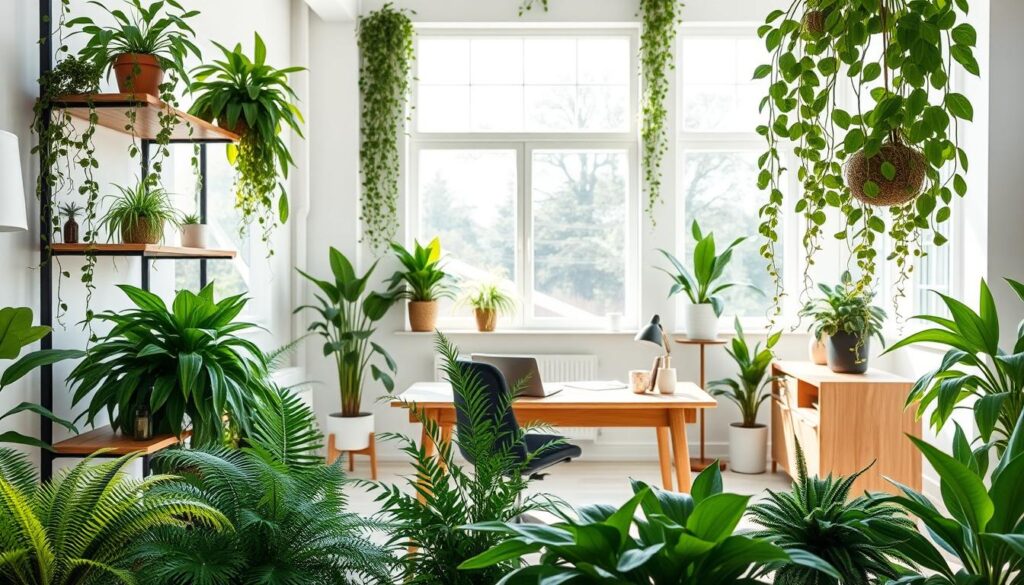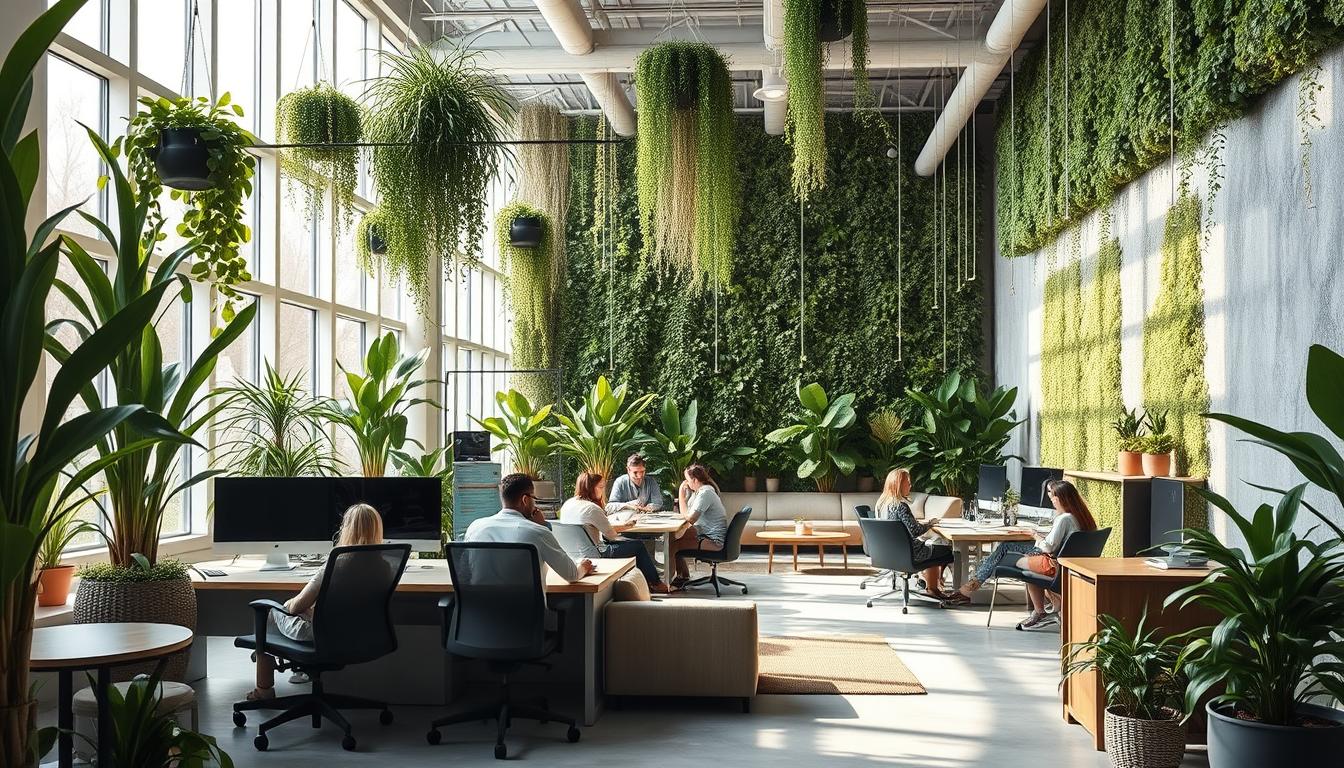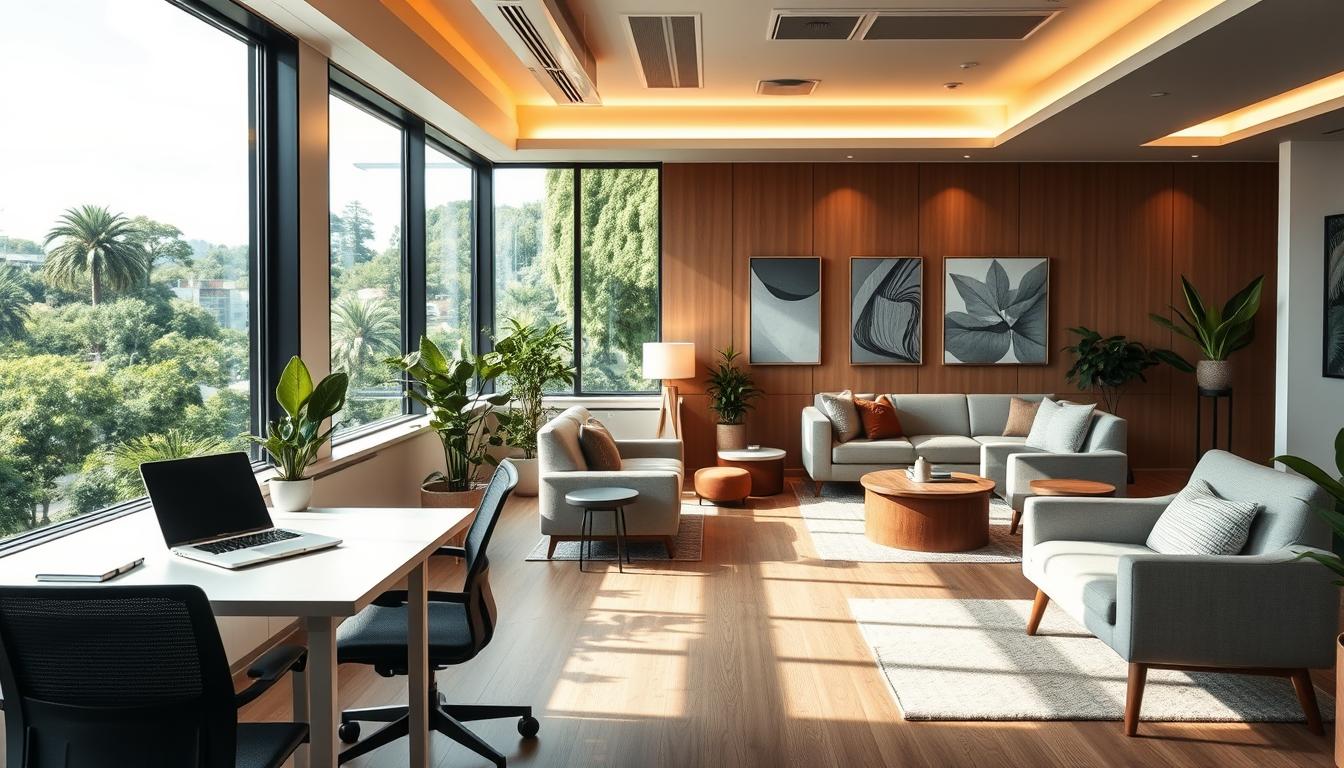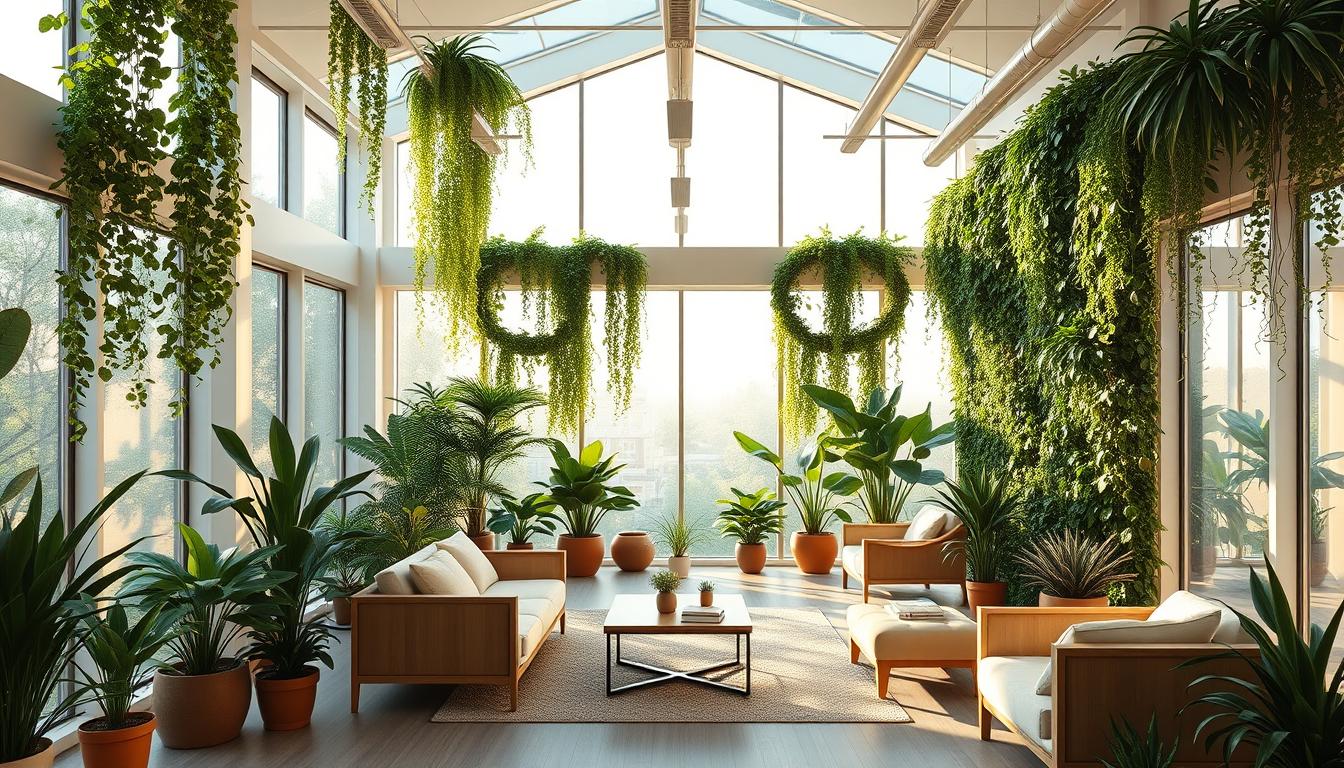Adding real plants to shared workspaces is a game changer for improving office vibes. They do more than just look nice. They help employees feel good and work better. Big names like Apple and Amazon use plants in their design. This shows that greenery can lift spirits, lower stress, and make the air cleaner. Studies prove that workspaces with plants lead to happier and more focused employees. So, having real plants is a smart move for both the happiness of employees and the success of a company.
The Importance of Biophilic Design in Workspaces
Adding biophilic design to workspaces changes how people relate to their surroundings. This approach mixes natural elements with built environments, creating a natural bond. It makes work areas look better and fosters a peaceful vibe. This increases job happiness and overall satisfaction.
Defining Biophilic Design
Biophilic design connects people to nature in their workspaces. It includes plants, water, and sunlight in the design. This method boosts well-being, sparks creativity, and makes workers more productive.
Why Does It Matter?
Biophilic design is key because it makes workers happier. Studies confirm that nature drops stress and lifts moods. In nature-filled offices, workers feel more content and part of a community. This leads to better work and helps companies thrive.

Real Plants in Shared Workspaces: The Benefits
Adding real plants to shared workspaces offers many benefits that go beyond just looking nice. Greenery makes these areas more welcoming for employees. It turns dull spaces into lively ones, boosting creativity and teamwork.
Enhancing Aesthetic Appeal
Plants act as natural decorations, brightening up work areas. They make offices less boring by adding color and focus points. A nice-looking workspace improves mood and sparks creativity, making people more productive.
Creating a Welcoming Environment
Real plants make workspaces feel more like home, helping everyone feel part of the team. Being around plants can make people happier and more engaged at work. Workplaces that care about looks and nature can help keep their employees happy and connected.
Improvement of Air Quality
Adding plants to shared workspaces can make the air better. Some studies say plants don’t clean the air as much as we thought in offices. But, the good feelings plants give should not be ignored. Workers enjoy better air quality when plants are around. This can boost their productivity and happiness at work.
The Role of Plants in Air Purification
Plants help clean the air by soaking up bad stuff. They take in things like harmful gases and toxins. Adding plants helps make office air healthier. Greenery makes the space feel fresher and cuts down on air quality complaints.
Common Indoor Pollutants Addressed
Office air can have pollutants that harm our health. The usual suspects are:
- Volatile Organic Compounds (VOCs)
- Formaldehyde
- Carbon Dioxide
- Dust and Allergens
Plants fight these pollutants and help clean the air. This means workers might have fewer health problems from air pollution.
Impact on Employee Mental Health
Putting plants in work areas greatly helps with employee mental health. Many studies show that more greenery lowers stress and makes people feel better overall. Having nature in offices creates a nice environment that is also good for the mind.
Stress Reduction Through Greener Environments
Studies often find that nature helps reduce stress. Workers around plants feel calmer and happier. Green spaces help cut down on nervousness, making the workplace more peaceful. This change makes employees more relaxed and eager to work, leading to a better work setting.
The Psychological Benefits of Nurturing Plants
Looking after plants gives mental health benefits beyond just looking nice. It gives workers a sense of duty and pride. Caring for plants makes emotional ties stronger and gives people more purpose in their jobs, which boosts mental health. Workplaces with plants create a supportive environment, improving job happiness and spirit.
Enhancing Productivity Levels
Adding plants to your work area can greatly improve productivity. Studies have found that workers surrounded by plants are up to 15% more productive. This is likely because biophilic design makes workplaces better.
Studies Supporting Productivity Gains
Many studies show that plants boost productivity. They make work spaces look nice and help people think better. This leads to higher concentration. Workplaces with plants see happier staff and better work outcomes.
Increasing Focus and Concentration
Plants help make the workplace calmer. This makes it easier for employees to focus. A pleasant environment with plants helps people feel good. This lets teams get more done.
Humidity Control and Comfort
Keeping the right humidity level in modern offices is key for comfort. The use of heating and cooling systems can make indoor air very dry. Real plants can solve this by naturally adjusting humidity, making the indoor environment better.
How Plants Regulate Humidity
Plants help control humidity through transpiration. This is when they take up water from the ground and release moisture into the air through their leaves. This process makes the air more humid and less dry, which makes for a nicer working environment. Thus, having plants around makes the office feel better and keeps employees happy.
Combating Dry Indoor Air Issues
Dry air indoors can cause skin and breathing issues. Adding plants to the office can fix these problems. More humidity means more comfort and fewer health complaints from the staff. In short, plants make for a happier, healthier office.
Fostering Social Interaction and Collaboration
Adding plants to office spaces does more than make them look good. It greatly boosts how people interact and work together. Offices use plants as natural screens. These green barriers help everyone focus while feeling connected to their colleagues.
Plants as Natural Dividers in Open Spaces
In offices with no walls, plants help mark where one person’s space ends and another’s begins. This helps mix private time with team chats, without too many interruptions. Plus, the plants make the office more welcoming overall.
Encouraging Team Building and Connections
Plants in the office lead to more chats and team work. They create spots where people gather, share ideas, and collaborate, boosting team spirit. As the office feels cozier, everyone is more likely to bond, fostering a lively work atmosphere.
Choosing the Right Plants for Shared Workspaces
Choosing the right plants for shared workspaces is key to creating a nature-infused office environment. The perfect plant choices do more than just look good. They help employees feel better and work smarter. Consider the plant’s need for light and how much care it will need to thrive and bring benefits.
Low-Maintenance Options
Busy workspaces need plants that don’t require a lot of attention. Here are some good choices:
- Snake plants stand tough and need little attention to stay healthy.
- ZZ plants do well in shadowy corners with just a bit of water now and then.
- Peace lilies, needing minimal light, add beauty and clean the air at the same time.
Considerations for Office Lighting
Lighting is crucial when picking plants for an office. Each plant has its own light needs:
- Succulents love bright light to reach their full potential.
- Shade-loving plants like pothos prosper even in low-light spots.
- Knowing the natural light in your workspace helps in selecting plants that will flourish, making the office healthier.
Case Studies of Successful Plant Integration
Many top companies with plants have become models for successful plant integration in their workspaces. These case studies show that greenery makes offices look better and creates a productive, healthy atmosphere.
Examples from Leading Companies
Big organizations have used plants to make their employees more engaged and happy. For example, Google and Facebook have put a lot of effort into adding green spaces in their offices. They are invested in designs that connect people to nature because it helps with mental health and makes the workplace look good. These actions have changed shared workspaces into places where people thrive.
Measurable Outcomes from Plant Introductions
Case studies point out the big benefits of adding plants to offices. At Amazon, putting plants in office spaces led to fewer employees missing work. It shows how a space with more plants can have a big positive effect. Also, studies say that plants in the workspace help people concentrate better and be more productive. These results prove that plants can make the office environment healthier.
The Cost-Benefit Analysis of Workplace Plants
Adding plants to the office is a decision that needs a close look at costs versus benefits. Even though starting with office plants might cost a bit, they bring big advantages over time. Studies show that plants improve worker happiness, spark creativity, and cut down on days missed. All of this helps create a better office atmosphere. It proves why it’s smart to have plants in work areas.
Initial Investments vs. Long-Term Benefits
Starting costs for office greenery include buying, taking care of, and placing the plants. However, these costs are balanced by the great benefits they bring. These are benefits like:
- Less health complaints
- More productive employees
- Greater job happiness
This creates a work environment that leads to money gains in the long run. So, the upfront money spent seems small against all these good things.
Return on Investment Metrics
To really get the full picture of what office plants offer, companies look at certain numbers. These numbers show how much plants help. Important things to watch are:
- More work done, shown by how much is produced
- Fewer sick days and less time off needed
- Better employee stay rates, which means saving on hiring costs
All of this makes a strong argument for putting money into plants. It leads to a work place that’s healthier and where more gets done.
Conclusion
Adding real plants to shared offices brings many good changes. They make the air cleaner and help workers feel mentally better. This leads to more work done and a friendly place to work. Happy and satisfied workers make for a better workplace.
Studies and real examples show that adding nature, like plants, to offices is key today. Big companies doing this see more engaged workers and better work outcomes. This strengthens the argument for plants in work areas.
Companies are seeing how important it is to look after their workers’ happiness. Putting real plants in shared areas is a clear step in the right direction. It shows a commitment to caring for the planet and makes workspaces healthier and more productive for everyone.



